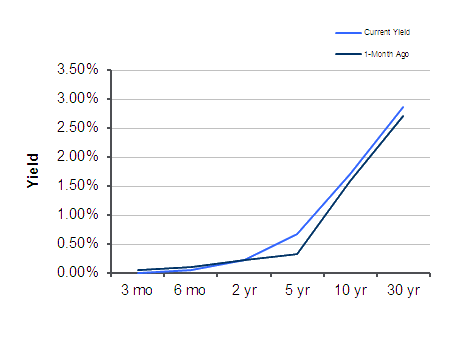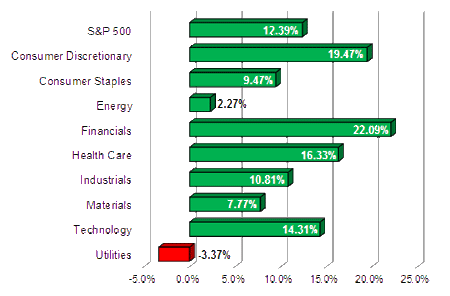
Market Commentary by Scott J. Brown, Ph.D., Chief Economist
 As expected, the Federal Open Market Committee decided to fold purchases of $45 billion per month in long-term Treasuries into QE3 when Operation Twist ends later this year (in Operation twist, the Fed is buying $45 billion per month in long-term Treasuries and selling a similar amount of shorter-term Treasuries out of its portfolio). Thus, the Fed will continue buying $85 billion in long-term assets in 2013 ($45 billion in Treasuries, $40 billion in mortgage-backed securities), with no specified ending date, until there is “substantial improvement” in labor market conditions.
As expected, the Federal Open Market Committee decided to fold purchases of $45 billion per month in long-term Treasuries into QE3 when Operation Twist ends later this year (in Operation twist, the Fed is buying $45 billion per month in long-term Treasuries and selling a similar amount of shorter-term Treasuries out of its portfolio). Thus, the Fed will continue buying $85 billion in long-term assets in 2013 ($45 billion in Treasuries, $40 billion in mortgage-backed securities), with no specified ending date, until there is “substantial improvement” in labor market conditions.
The Fed also shifted the language in its forward guidance on the overnight lending rate from dates to economic thresholds. Specifically, the Fed “currently anticipates that the exceptionally low range for the federal funds rate will be appropriate at least as long as the unemployment rate remains above 6.5%, inflation between one and two years ahead is projected to be no more than a half percentage point above the Committee’s 2% longer-run goal, and longer-term inflation expectations continue to be well anchored.”The 6.5% unemployment rate is a threshold, not a target, a guidepost for policy, not a goal. The 2.5% inflation threshold suggests a greater tolerance for inflation, but Fed officials continue to expect inflation to trend at or below the 2% target over the next few years. As it is, the economic threshold guidance is currently the same as the previous date guidance (“mid-2015”).
There was little progress in negotiations on the fiscal cliff. The economic data reports reflected a rebound in retail sales and industrial production following the effects of Hurricane Sandy. Inflation figures remain low, with headline figures held down by lower energy costs.
Next week, the economic data are not seen as critical, but there could be some market reactions if we get any surprises. The market focus is likely to remain on Washington. The odds of a deal on the fiscal cliff by the end of the year should continue to decline, but an agreement to postpone much of the impact remains likely in January.
Indices
| Last | Last Week | YTD return % | |
| DJIA | 13170.72 | 13074.04 | 7.19% |
| NASDAQ | 2992.16 | 2989.27 | 14.48% |
| S&P 500 | 1419.45 | 1413.94 | 12.39% |
| MSCI EAFE | 1583.77 | 1569.46 | 13.66% |
| Russell 2000 | 824.20 | 821.79 | 10.63% |
Consumer Money Rates
| Last | 1-year ago | |
| Prime Rate | 3.25 | 3.25 |
| Fed Funds | 0.18 | 0.07 |
| 30-year mortgage | 3.34 | 3.94 |
Currencies
| Last | 1-year ago | |
| Dollars per British Pound | 1.610 | 1.553 |
| Dollars per Euro | 1.307 | 1.308 |
| Japanese Yen per Dollar | 83.470 | 77.940 |
| Canadian Dollars per Dollar | 0.985 | 1.029 |
| Mexican Peso per Dollar | 12.821 | 13.785 |
Commodities
| Last | 1-year ago | |
| Crude Oil | 85.89 | 100.14 |
| Gold | 1696.99 | 1657.72 |
Bond Rates
| Last | 1-month ago | |
| 2-year treasury | 0.23 | 0.24 |
| 10-year treasury | 1.70 | 1.60 |
| 10-year municipal (TEY) | 2.80 | 2.85 |
Treasury Yield Curve – 12/14/2012
S&P Sector Performance (YTD) – 12/14/2012
Economic Calendar
| December 17th |
— |
Empire St. Manufacturing Index (December) |
| December 18th |
— |
Current Account Deficit (3Q12) Homebuilder Sentiment (December) |
| December 19th |
— |
Building Permits, Housing Starts (November) |
| December 20th |
— |
Jobless Claims (week ending December 15th) Real GDP (3Q12, 3rd estimate) Philadelphia Fed Index (December) Leading Economic Indicators (November) |
| December 21st |
— |
Personal Income and Spending (November) |
| December 24th |
— |
Durable Goods Orders (November) |
| December 25th |
— |
Christmas Holiday (markets closed) |
| December 27th |
— |
Consumer Confidence (December) |
| January 1st |
— |
New Year’s Holiday (markets closed) |
| January 4th |
— |
Employment Report (December) |
| January 30th |
— |
FOMC Policy Decision (no Bernanke press briefing) |
Important Disclosures
US government bonds and treasury bills are guaranteed by the US government and, if held to maturity, offer a fixed rate of return and guaranteed principal value. US government bonds are issued and guaranteed as to the timely payment of principal and interest by the federal government. Treasury bills are certificates reflecting short-term (less than one year) obligations of the US government.
Commodities trading is generally considered speculative because of the significant potential for investment loss. Markets for commodities are likely to be volatile and there may be sharp price fluctuations even during periods when prices overall are rising. Specific sector investing can be subject to different and greater risks than more diversified investments.
Tax Equiv Muni yields (TEY) assume a 35% tax rate on triple-A rated, tax-exempt insured revenue bonds.
![]() Material prepared by Raymond James for use by its financial advisors.
Material prepared by Raymond James for use by its financial advisors.
The information contained herein has been obtained from sources considered reliable, but we do not guarantee that the foregoing material is accurate or complete. Data source: Bloomberg, as of close of business December 13th, 2012.
©2012 Raymond James Financial Services, Inc. member FINRA / SIPC.




